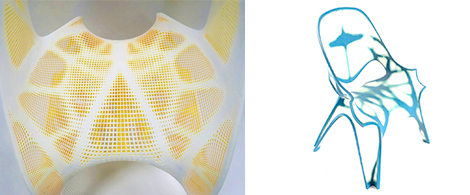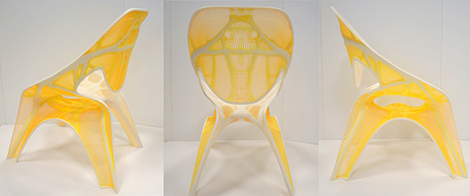//giphy.com/embed/AJsx70S4D9CWQ
In time for the Zaha Hadid retrospective, a 10 room showcase of the late designer’s work running as part of the Venice Biennial celebrations, Stratasys has unveiled some of the design process behind her practise’s designs for a 3D printed chair.
3D printed on the Stratasys Objet1000 multi-material 3D printer, the piece of furniture was developed specifically to explore the possibilities of multi-color, multi-material 3D printing, the starting point for ZHA was to design a relatively lightweight chair that made use of its geometry, detailing and manufacture to highlight and improve its performance.
Investigating the design potentials of the structural optimisation process, ZHA considered the loading condition of a person sitting down, and used the optimisation results to create a structural pattern that deploys material density and depth where structurally required.

3D printed with structural optimisation key, and a colour scheme derived from stress analysis maps
“3D printed design projects such as this collaboration with Stratasys are of significant importance for the wider industry,” commented ZHA associate Shajay Bhooshan.
“The 3D printed chair epitomizes the bi-directional influence between technology and the way we design that we are always striving to create.”
The structural elements were translated into the design, with Stratasys able to 3D print the chair using gradations of color and opacity, from clear transparent to opaque cyan, to represent the structural performance of each area of the chair – an aesthetic touch applied almost like an analysis model.
Since the development of the original 3D printed prototype in 2014, the chair has been showcased at various exhibitions and museums around Europe, and has continued to be a representation of Zaha Hadid Architects’ commitment to 3D printing.

The chair is being displayed as part of a special retrospective of Hadid’s work at the Venice Biennial






